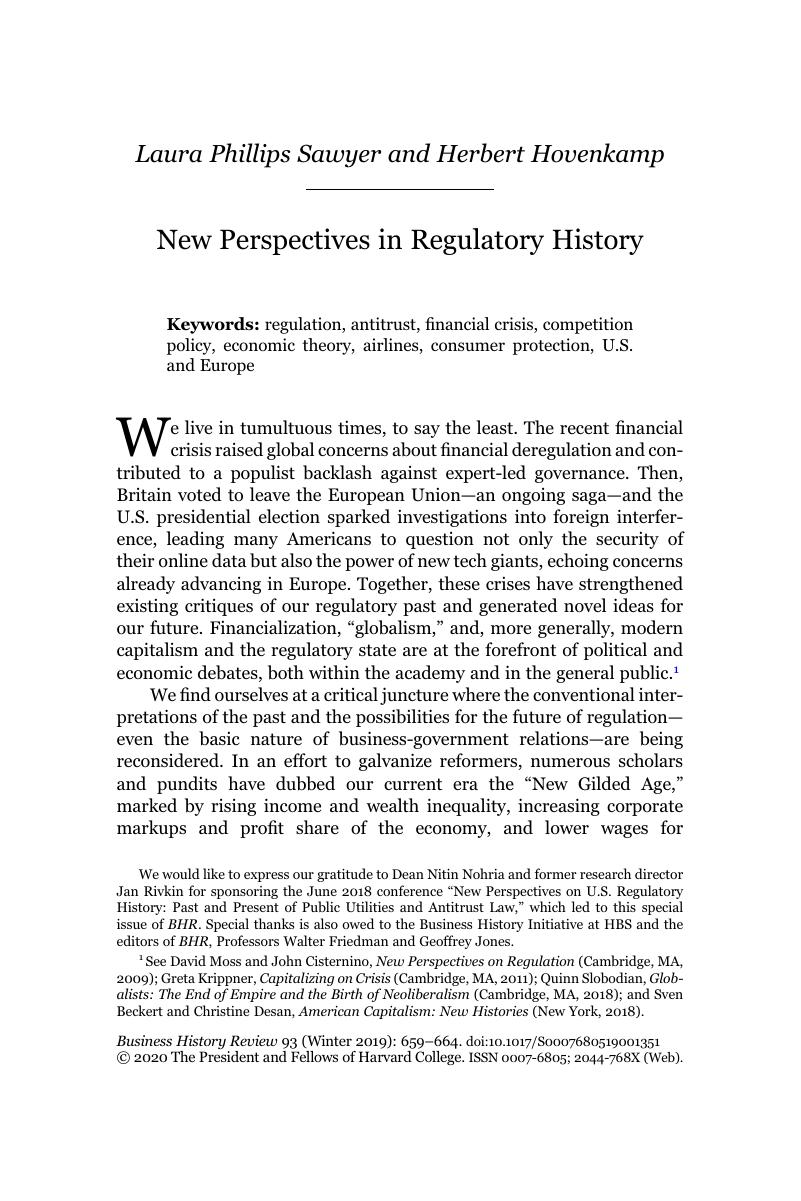Article contents
New Perspectives in Regulatory History
Published online by Cambridge University Press: 20 January 2020
Abstract

Keywords
- Type
- Introduction
- Information
- Business History Review , Volume 93 , Issue 4: New Perspectives in Regulatory History , Winter 2019 , pp. 659 - 664
- Copyright
- Copyright © The President and Fellows of Harvard College 2020
Footnotes
We would like to express our gratitude to Dean Nitin Nohria and former research director Jan Rivkin for sponsoring the June 2018 conference “New Perspectives on U.S. Regulatory History: Past and Present of Public Utilities and Antitrust Law,” which led to this special issue of BHR. Special thanks is also owed to the Business History Initiative at HBS and the editors of BHR, Professors Walter Friedman and Geoffrey Jones.
References
1 See Moss, David and Cisternino, John, New Perspectives on Regulation (Cambridge, MA, 2009)Google Scholar; Krippner, Greta, Capitalizing on Crisis (Cambridge, MA, 2011)Google Scholar; Slobodian, Quinn, Globalists: The End of Empire and the Birth of Neoliberalism (Cambridge, MA, 2018)CrossRefGoogle Scholar; and Beckert, Sven and Desan, Christine, American Capitalism: New Histories (New York, 2018)CrossRefGoogle Scholar.
2 See Fiona Scott Morton, “Modern U.S. Antitrust Theory and Evidence amid Rising Concerns of Market Power and Its Effects” (research paper, Center for Equitable Growth, Washington, DC, 29 May 2019), https://equitablegrowth.org/research-paper/modern-u-s-antitrust-theory-and-evidence-amid-rising-concerns-of-market-power-and-its-effects/; Jan De Loecker and Jan Eeckhout, “The Rise of Market Power and the Macroeconomic Implications” (NBER Working Paper No. 23687, Cambridge, MA, Aug. 2017); Simcha Barkai and Seth G. Benzell, “70 Years of US Corporate Profits” (Stigler Center for the Study of the Economy and the State, University of Chicago Booth School of Business, New Working Paper Series No. 22, Apr. 2018); José Azar, Ioana Marinescu, and Marshall I. Steinbaum, “Labor Market Concentration” (NBER Working Paper No. 24147, Cambridge, MA, issued Dec. 2017, revised Feb. 2019).
3 See Rogers, Daniel, Atlantic Crossings: Social Politics in a Progressive Age (Cambridge, MA, 1998), 5Google Scholar.
4 Rogers, 6.
5 Tunku Varadaraja, “The Romance of Economics,” Wall Street Journal, 22 July 2006.
6 For an example of institutionalist economists’ logic of segmented market regulation, see Justice Louis Brandeis's opinion in Chicago Board of Trade v. United States, 246 U.S. 231 (1918). On imperfect competition, see Robinson, Joan, The Economics of Imperfect Competition, 2nd ed. (New York, 1969)CrossRefGoogle Scholar. On monopolistic competition, see Chamberlin, William, The Theory of Monopolistic Competition (Cambridge, MA: 1933)Google Scholar.
7 For example, see Stigler, George, “Monopolistic Competition Based in Retrospect,” in The Organization of Industry (Chicago, 1983), 309–21Google Scholar. See also Stiglitz, Joseph, “Government Failure vs. Market Failure: Principles of Regulation,” in Government and Markets: Toward a New Theory of Regulation, ed. Balleisen, Ed and Moss, David (Cambridge, U.K., 2010)Google Scholar.
8 On the impact of new economic ideas, such as behaviorialism and game theory, on antitrust law and policy, see Herbert Hovenkamp and Fiona Scott Morton, “Framing the Chicago School of Antitrust Analysis,” University of Pennsylvania Law Review (forthcoming).
9 It was almost thirty years ago that Theda Skopol demonstrated the powerful presence of the state and the often overlooked and autonomous force of bureaucratic politics in the early twentieth century. Skopol, Protecting Soldiers and Mothers: The Political Origins of Social Policy in the United States (Cambridge, MA, 1992). Since then, the interdisciplinary movement in American political development has influenced numerous scholarly projects. On “unseen” or overlooked regulations, see Novak, William, The People's Welfare: Law and Regulation in Nineteenth-Century America (Chapel Hill, 1996)Google Scholar; Balogh, Brian, A Government Out of Sight: The Mystery of National Authority in Nineteenth-Century America (Cambridge, U.K., 2009)CrossRefGoogle Scholar; Balogh, The Associational State: American Governance in the Twentieth Century (Philadelphia, 2015). On “mezzo-level” bureaucrats, see Carpenter, Daniel P., The Forging of Bureaucratic Autonomy: Reputations, Networks, and Policy Innovation in Executive Agencies, 1862–1928 (Princeton, 2001)Google Scholar.
10 McCraw, Thomas K., introduction to Regulation in Perspective: Historical Essays, ed. McCraw, Thomas K. (Cambridge, MA, 1981)Google Scholar, vii, viii. The pathbreaking authors in that volume, McCraw wrote, “have typically chosen to study bureaucratic adaptations to cultural movement and have often focused their research on the thought and behavior of professionals operating within complex organizations or doing battle against them from without.” The same holds true here.
11 On the “adversarial tradition,” see McCraw, Thomas K., Prophets of Regulation: Charles Francis Adams, Louis D. Brandeis, James M. Landis, Alfred E. Kahn (Cambridge, MA, 1984)Google Scholar.
12 Government and Markets: Toward a New Theory of Regulation, ed. Edward J. Balleisen and David A. Moss (Cambridge, U.K., 2010).
- 2
- Cited by




